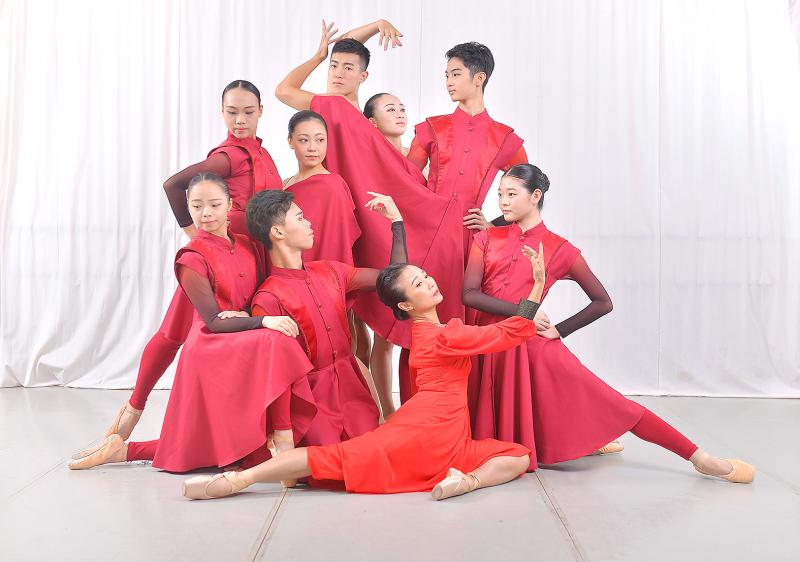Kaohsiung City Ballet’s (KCB, 高雄城市芭蕾舞團) annual August performances are a chance for the company’s more senior dancers to display their talents, and for dance fans to see something besides modern dance.
For the past three years, company founder Chang Hsiu-ru (張秀如) has tapped Romanian choreographer and video artist Constantin Georgescu to either create a new work for the August productions — including 2017’s Light (光) and last year’s Water (水) or help her restage some classics of the Western ballet canon, as she did for 2018’s 19th Century Romanic Ballets (世紀浪漫芭蕾—仙女—吉賽兒—四人舞).
Georgescu was her first choice again for this year’s show, which follows the basic element theme she started in 2017, but for Fire (火), unlike Light or Water, he was tasked not with creating a short piece for a double bill, but a full-length work.

Photo courtesy of the Kaohsiung City Balle
The multi-talented artist said he was inspired by Chang’s choice of theme.
“Fire is an element of transformation, it is energy, power, and creation. It is often used as a symbol for passion, holiness and purification, but also for conflict, aggression and war,” he said.
While fire has fueled major technological developments, it has also been a force for aggression and destruction — against nature or other humans, which made him think about fire as a phenomena caused by human behavior, as well as its symbolism.
Georgescu said Fire is divided into three sections.
In the first, fire is represented by a warrior — someone who is a hero, but also leaves behind him a trail of destruction.
In the second, fire is a sleeping woman whose hopes burn as bright as a candle, he said.
The woman is waiting for the right time, place and person to help her — until she realizes that she is that person herself, and the right time is now, he said, adding that the inspiration for the characters came from a very familiar source, the fairy tale and well-known ballet, Sleeping Beauty.
In the third part, fire as a destructive and constructive force is explored through group dynamics.
Georgescu said he choose a score made up of several string and piano pieces, because he wanted to capture different states and textures similar to those of the different constructs of fire.
His staging, while minimal, is sure to delight audiences, given his track record with the company’s productions of Coppelia (2014) and The Nutcracker in 2015, as well as his own works.
Fire premieres on Saturday at the Pingtung Performing Arts Center, followed by a show in Kaohsiung on Friday night next week, and then one in Taichung the following Tuesday.
It is a pity that the company is not traveling as far as Taipei for this tour, both for the dancers, including veterans Ally Yeh (葉麗娟), Maurice Ssu-tu Ping-hsuan (司徒秉宸), Hsu Chia-jung (許佳蓉) and Eavy Wang Yu-wei (王語薇), and audiences in the capital.

That US assistance was a model for Taiwan’s spectacular development success was early recognized by policymakers and analysts. In a report to the US Congress for the fiscal year 1962, former President John F. Kennedy noted Taiwan’s “rapid economic growth,” was “producing a substantial net gain in living.” Kennedy had a stake in Taiwan’s achievements and the US’ official development assistance (ODA) in general: In September 1961, his entreaty to make the 1960s a “decade of development,” and an accompanying proposal for dedicated legislation to this end, had been formalized by congressional passage of the Foreign Assistance Act. Two

Despite the intense sunshine, we were hardly breaking a sweat as we cruised along the flat, dedicated bike lane, well protected from the heat by a canopy of trees. The electric assist on the bikes likely made a difference, too. Far removed from the bustle and noise of the Taichung traffic, we admired the serene rural scenery, making our way over rivers, alongside rice paddies and through pear orchards. Our route for the day covered two bike paths that connect in Fengyuan District (豐原) and are best done together. The Hou-Feng Bike Path (后豐鐵馬道) runs southward from Houli District (后里) while the

March 31 to April 6 On May 13, 1950, National Taiwan University Hospital otolaryngologist Su You-peng (蘇友鵬) was summoned to the director’s office. He thought someone had complained about him practicing the violin at night, but when he entered the room, he knew something was terribly wrong. He saw several burly men who appeared to be government secret agents, and three other resident doctors: internist Hsu Chiang (許強), dermatologist Hu Pao-chen (胡寶珍) and ophthalmologist Hu Hsin-lin (胡鑫麟). They were handcuffed, herded onto two jeeps and taken to the Secrecy Bureau (保密局) for questioning. Su was still in his doctor’s robes at

Mirror mirror on the wall, what’s the fairest Disney live-action remake of them all? Wait, mirror. Hold on a second. Maybe choosing from the likes of Alice in Wonderland (2010), Mulan (2020) and The Lion King (2019) isn’t such a good idea. Mirror, on second thought, what’s on Netflix? Even the most devoted fans would have to acknowledge that these have not been the most illustrious illustrations of Disney magic. At their best (Pete’s Dragon? Cinderella?) they breathe life into old classics that could use a little updating. At their worst, well, blue Will Smith. Given the rapacious rate of remakes in modern